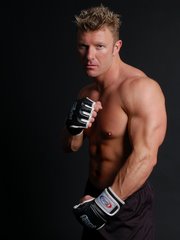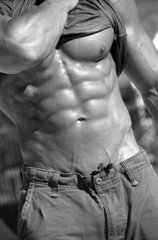workout series: baby got backThe muscles of the back are important for many activities as well as maintaining good posture and balance. Whether your sport involves swinging a bat, throwing a basketball, smacking a puck or just lifting groceries out of the trunk of your car... strong back muscles can improve performance and reduce your risk of injury. Even if you don't want "big wings" like Arnold... strengthening your back can make everyday activities easier and help you feel great. |
| Incorporating these exercises into your regular workouts can help you develop your back muscles. Periodically change the exercises and/or amount of weight that you lift (depending on your goals) to avoid plateaus and keep your muscles stimulated. Don't neglect other parts of your body. It's important to do a full-body workout to develop a well-rounded look and prevent muscular imbalance. |
| As with any resistance training program, how you lift depends on your specific goals. If you don't know how to lift to reach your goals, talk to one of our fitness professionals for more information. If you've had any type of back pain or previous back injuries you should check with your doctor for specific limitations prior to starting a new workout program. |
| The muscles involved, how they attach to the body and the movements they perform are important for any resistance training exercise. Performing an exercise incorrectly or forcing the body into an unnatural position will reduce the effectiveness of the movement and greatly increase your risk of injury. If you have any questions ask for a demo from one of our fitness professionals. Keeping the the "action" and "attachment" in mind while performing an exercise can help you maintain the proper technique. |
lower backMuscles: the spinal erectorsAttachment: these muscles originate on the pelvis, vertebrae and ribs and attach to the ribs, vertebrae and back of the skull. Action: extension and lateral flexion of the spine. |
lower back exercises:
|
upper backMuscles: latissimus dorsi, teres major and rear deltoid.Attachments: the lats originate on the vertebrae and pelvis and attache to the upper front part of the humerus (bone of the arm); the teres major and the rear deltoid originate on the shoulder blade and attach to the upper bone of the arm (humerus). Action: all three muscles bring the arm closer to the body (as in a pull up) and also extend the shoulder. |
upper back exercises: |
pull downs:
* Skip the behind the neck pull-ups and behind the neck lat pull-downs. These exercises are less effective based on the physiology of the muscles (how they attach and the movement they perform). Behind the neck movements also increase the risk of injury because the shoulder joint is placed in an unnatural position increasing stress to the joint during movement. Leaning your head forward to complete a behind the neck exercise also places the head/neck in an unnatural position and even more risk of injury. |
rows:Wide-Grip Bent Over Barbell Row: using a straight barbell, stand with your feet close together and your knees slightly bent. Bend over slightly at the waist and keep your back straight. Limiting movement in your body, pull the barbell up towards your abdomen. Repeat 8-12 reps. Rest and repeat according to your specific goals/abilities. ** Keeping your shoulder blades in their natural position throughout a row exercise creates a more effective exercise. When your shoulder blades extend forward the muscles must pull the shoulder blades back into their natural position before the exercise movement can be performed. Returning to a natural shoulder position reduces the amount of time resistance is applied to the muscle and reduces the efficiency of the exercise. |
straps or no straps?Because your back muscles can lift more weight than your grip can usually handle, many people like to use straps to increase the amount they lift. Some people don't like straps because they don't allow you to develop grip strength. So who's right? Depends on your individual goals and why you're lifting. If grip strength is important to you or for a specific sport (i.e. rock climbing) then you shouldn't use straps. If your goal is overall health and fitness and grip strength isn't an issue, straps can improve your workout for the larger muscle groups. It all depends on your goals. |
If you're interested in fitness, bodybuilding, loosing weight, wanting to be fit, or just interested in fitness! You came to the right place! Stay in touch with all the latest news! Check out the Blog Archive! :)
Wednesday, July 25, 2007
Workout Series: Baby got back
Subscribe to:
Post Comments (Atom)

















No comments:
Post a Comment